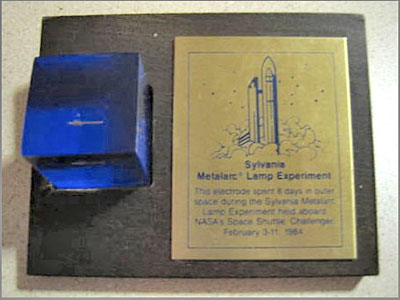Shuttle Experiments Show How Zero Gravity Affects GasesCameras took time-lapse photographs of the glowing gases in ordinary commercial arc lamps to observe the behavior of the gases in the absence of gravity.
Predictably the gases behaved differently in space, without the disturbances of gravitational convection forces, than they did in comparable light bulbs photographed on the earth. The orbiting lights burned brighter and more efficiently, according to researchers at the GTE Corporation, which developed and analyzed the experiment.
The photographs, showing the more uniform flow of gases in the orbiting tubes, were also striking illustrations of work in a new but increasingly active field of research, the study of zero-gravity phenomena. Such research has been conducted on nearly all of the nation's shuttle flights and, in a few cases, could lead to space-based industrial processes.
Joseph M. Proud, director of the Technology Center for Physical Electronics at GTE Laboratories in Waltham, Mass., emphasized in an interview that the light-bulb experiment was basic research aimed at understanding the circulation of hot gases inside an arc light, not a precursor of made-in-space light bulbs.
Once the effects of gravity were eliminated, the influences of temperature differentials and the electric fields could be seen more clearly, and so could their influence on the mixing and distribution of the chemicals inside the arc tube.
The results of the experiment, Dr. Proud said, will be used to construct computer models of the dynamics of arc lights. This could lead to the development of more efficient lights, possibly using different mixes of the key elements such as mercury vapor, argon and sodium. It could just possibly lead to the design of better light bulbs for space stations, Dr. Proud conceded.
In the experiment, which was developed under the direction of Alfred H. Bellows of GTE Laboratories, three Sylvania Metalarc lamps were installed in a canister the size of a household garbage can. A camera was focused on each lamp. The experiment was flown as one of the "Getaway Specials," the low-cost, self-contained packages that are carried in the shuttle cargo bay on a space- available basis.
The astronauts switched on power to each of the lamps for 30 minutes, during which time the camera snapped a photograph every seven seconds. The glowing gases were seen through four filters, one responsive to the whiteness of the light and the other three isolating radiations from the constituent elements - scandium, sodium and mercury. The photographs were examined with a microdensitometer, a kind of light meter that measures the light intensity of minute spots and constructs a contour map of the variations in light output. Temperatures were also monitored.
Harold L. Rothwell Jr., a GTE physicist, said: "The magnitude of the temperature increase in space was surprising. Gravity acts to take away energy you'd like to use to make light."
It is still unclear how many of this presentations were made.











